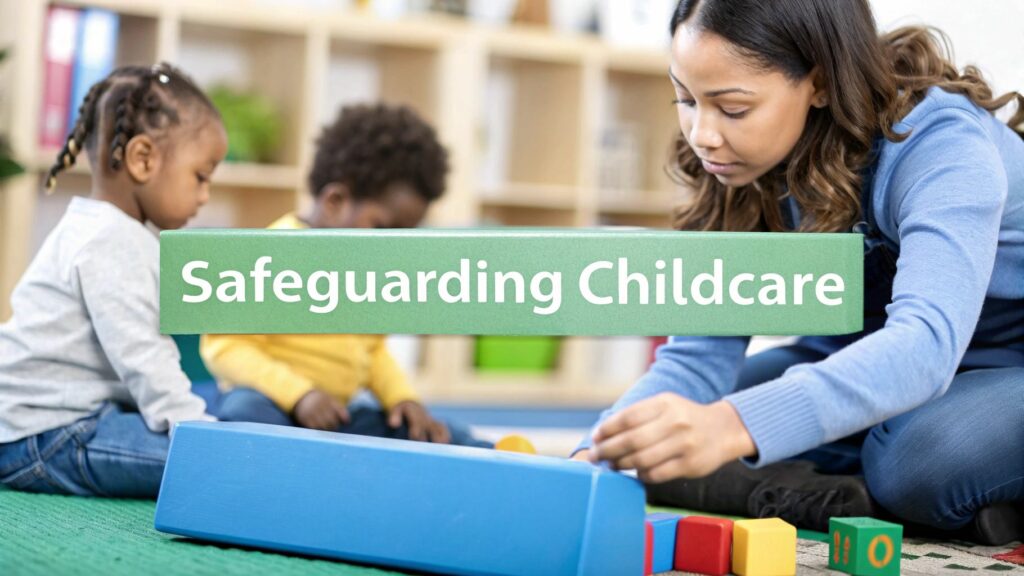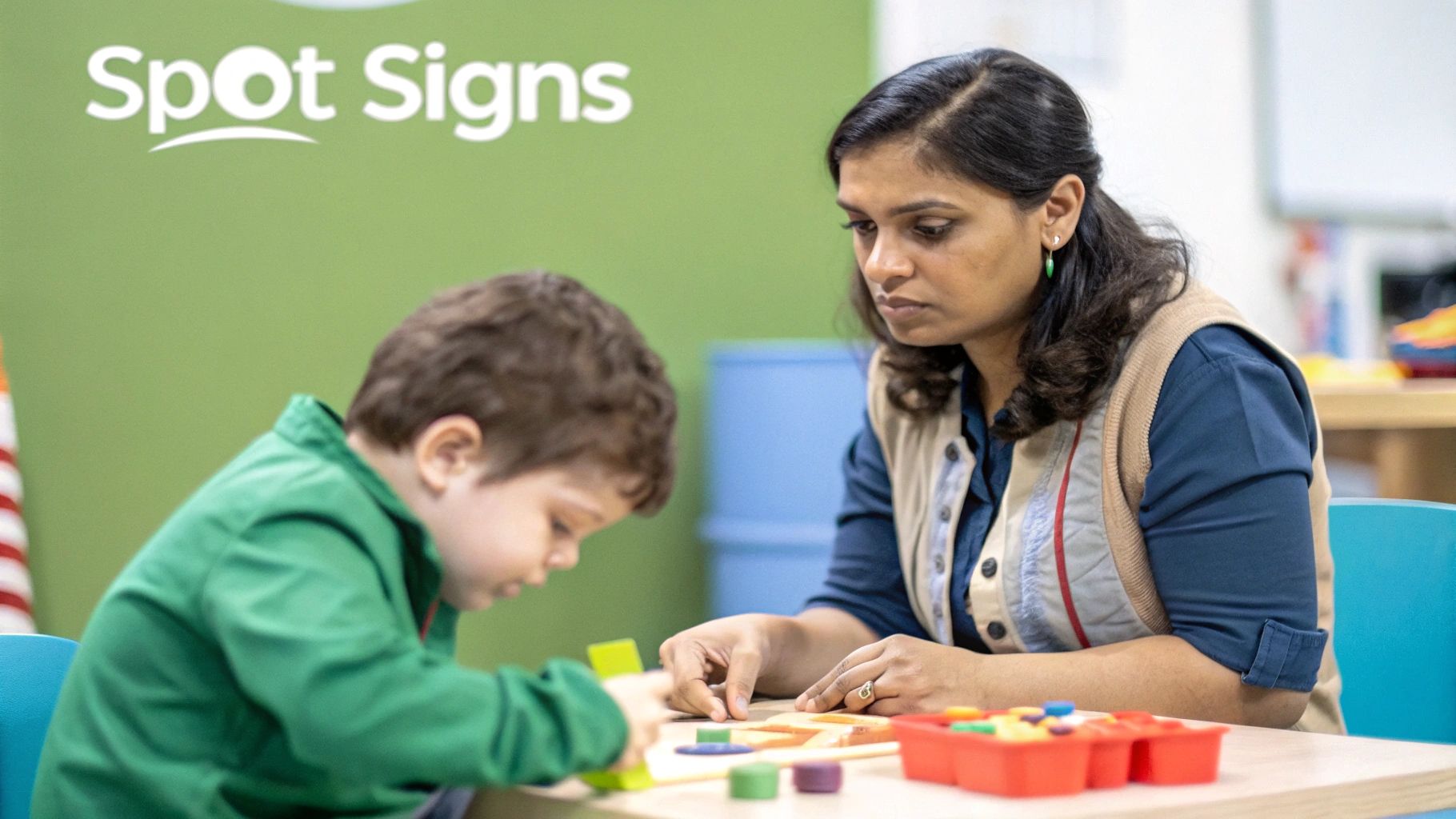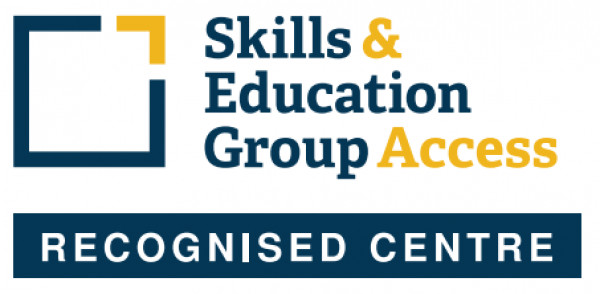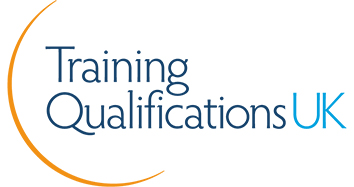
What is safeguarding in childcare? If you're considering a career working with children, it's the single most important duty you will ever have. Simply put, safeguarding is the process of protecting children from abuse, neglect, and harm. It’s about creating a secure, nurturing environment where every child can learn, play, and grow safely.
This guide will walk you through what safeguarding means in practice, why it's essential for anyone in childcare, and how you can gain the professional skills to protect children effectively.
Creating a Protective Environment for Children
At its heart, safeguarding is a set of proactive policies and actions designed to build a protective bubble around every child in your care. This isn't just about reacting when something goes wrong; it's about actively preventing harm before it can happen.
Think of it as the foundation of all quality childcare. It influences everything you do—from how you recruit staff and manage health and safety, to how you respond confidently when you suspect a child is at risk.
Safeguarding is the overall strategy for keeping children safe and well, while child protection involves the specific steps you take when you suspect harm. Understanding both is fundamental to the role of an Early Years Practitioner.
This table breaks down the core components into four key pillars, helping you grasp the concept right from the start.
The Four Pillars of Safeguarding in Childcare
|
Pillar |
Description |
Example in Practice |
|---|---|---|
|
Prevention |
Creating safe environments and robust policies to stop harm before it occurs. This is the proactive foundation of all safeguarding efforts. |
Carrying out thorough background checks (like DBS checks) on all staff and volunteers to ensure safe recruitment. |
|
Protection |
Taking direct action to support and protect children who are suffering or are at risk of significant harm. This is the reactive element. |
Following established procedures to report a concern about a child to the local authority’s children’s social care team. |
|
Promotion |
Actively promoting children’s health and development by ensuring they have opportunities to thrive in a safe and supportive setting. |
Teaching children about personal safety, consent, and their right to say “no” in an age-appropriate way. |
|
Partnership |
Working with other professionals, agencies, and parents to share information and coordinate efforts to ensure a child’s welfare. |
Attending multi-agency meetings to discuss a child’s needs and create a shared support plan with social workers and health visitors. |
By building your practice around these four pillars, you create a comprehensive framework that keeps children's welfare at the centre of everything you do.
The Scope of Safeguarding Responsibilities
Safeguarding responsibilities extend far beyond the nursery walls. It means being constantly vigilant about a child’s emotional, physical, and developmental wellbeing. This immense responsibility has, rightly, led to a highly regulated sector.
Safeguarding is not just a policy document that sits on a shelf. It is the active, ongoing commitment to see the world through a child's eyes and to act decisively to protect their right to be safe, healthy, and happy.
Proactive and Preventative Measures
A crucial part of effective safeguarding is creating an inherently safe space. This involves identifying and minimising potential risks before they can cause harm. It’s about more than just spotting signs of abuse; it includes practical steps like choosing the right essential baby safety products for home environments to guarantee a secure physical space for every child. This proactive mindset is the hallmark of a professional and effective childcare provider.
The Core Principles Every Childcare Professional Must Know
Safeguarding isn't just a list of rules; it's a way of thinking that should guide everything you do in an early years setting. To truly understand what safeguarding is about, you need to know the fundamental principles that shape every policy and professional judgement.
At the very heart of it all is the paramountcy principle. This is a simple but non-negotiable concept: a child's welfare must always come first. Every decision you make has to be made with the child's best interests as the top priority.
Adopting a Child-Centred Approach
This leads directly to the need for a child-centred approach. This is all about actively listening to each child and valuing what they have to say – their wishes, feelings, and perspective. It’s not just about their words; you have to pay close attention to their behaviour, how they play, and their non-verbal cues.
A child-centred approach means:
-
Active Listening: Genuinely hearing and respecting what children express, whether through words or actions.
-
Empowerment: Helping children understand their rights and giving them the confidence to speak up.
-
Individualised Care: Recognising that every child is unique and tailoring your support to fit their specific needs.
This approach ensures children are truly seen and heard. It shifts the focus from adults making assumptions and instead brings children into the conversation about their own safety and wellbeing.
Working in Partnership for Child Welfare
No single person or organisation can safeguard a child alone. Effective safeguarding is built on strong, collaborative partnerships. This starts with working closely with parents and carers, sharing information openly to build a circle of trust and support around the child.
But it also means joining forces with other professionals, like:
-
Local authority children’s social care teams
-
Health professionals, from health visitors to GPs
-
The police and other emergency services
This multi-agency teamwork is vital. Concerns often appear in different parts of a child's life, and by sharing information correctly, everyone involved can build a complete picture. This leads to the right support at the right time.
Statistics drive this home. In the year up to March 2025, a staggering 86% of serious incident notifications in the UK involved children already known to an agency. This highlights just how crucial ongoing communication is. You can explore these findings on the UK government's education statistics website.
When you embed these principles—putting the child first, listening to them, and working as a team—you move beyond just following rules. You embody the true spirit of safeguarding.
How to Recognise the Signs of Abuse and Neglect
Developing a keen eye for when something isn't right is one of the most crucial skills in safeguarding. As an Early Years Educator, you spend so much time with children, putting you in a unique position to spot subtle shifts in behaviour or appearance that others might miss.
Remember your role here. You aren't expected to be a detective or diagnose abuse. Your duty is to notice, record, and report your concerns accurately.

Trust your professional judgement. If your gut tells you a child is at risk, you have a duty to act. Understanding what to look for will give you the confidence to take the right steps and protect a child from harm.
Key Indicators Across Different Types of Abuse
Abuse and neglect can show up in countless ways. You’re often looking for a pattern of indicators or a combination of signs that, when put together, paint a concerning picture. Generally, these signs fall into four main categories.
Physical Abuse
This is when someone intentionally causes physical pain or injury to a child.
-
Unexplained injuries like bruises, burns, or cuts, especially in unusual patterns.
-
A child who seems frightened of their parents or other adults.
-
Wearing long-sleeved clothes in warm weather, as if trying to hide injuries.
-
Flinching or pulling away from sudden movements.
Emotional Abuse
This is the persistent emotional cruelty that damages a child's development and sense of self.
-
Sudden, dramatic changes in behaviour—a chatty child becomes withdrawn, or a calm child becomes aggressive.
-
A noticeable lack of confidence or, conversely, being desperate to please everyone.
-
Appearing emotionally immature for their age.
-
Displaying behaviour that doesn't fit their age, like being overly adult-like or acting much younger.
Sexual Abuse
This involves forcing or tricking a child into taking part in any kind of sexual activity.
-
Using sexual language or showing knowledge of things far beyond their years.
-
Complaining of unexplained pain or showing bruising around their genital area.
-
Suddenly becoming very secretive and pulling away from friends.
-
Displaying inappropriate sexualised behaviour towards other children or adults.
Neglect
This is the ongoing failure to provide for a child’s basic physical and emotional needs.
-
Always seeming hungry, tired, or appearing unwashed.
-
Having obvious medical or dental problems that are left untreated.
-
Wearing clothes that are completely wrong for the weather.
-
Being left alone for long periods or regularly unsupervised.
Of course, these lists aren't exhaustive. Your most powerful tools are your observation skills and maintaining the right attitude—one of compassionate curiosity. Learning the attitudes that can help care workers notice abuse is a professional skill you can build throughout your career.
Modern Challenges in Safeguarding
The world children navigate today brings new challenges. Online risks, in particular, have become a huge part of modern safeguarding.
Your responsibility extends beyond the physical classroom. Understanding digital dangers is now a non-negotiable part of what safeguarding in childcare means in the 21st century.
This means being vigilant for signs of:
-
Online Grooming: A child might become secretive about who they’re talking to online, receive gifts from an unknown person, or mention an older online "friend".
-
Radicalisation: Look out for a child who starts expressing extremist views, isolates themselves from friends, or develops an obsessive interest in violent ideas.
Recognising these newer signs comes down to the same core principle: building trusting relationships. When children feel safe with you, they’re more likely to open up about their experiences, whether they happened in the playroom or on a screen.
Understanding Your Role and Responsibilities
So, you know how to spot the potential signs of abuse, but what happens next? Knowing your specific duties takes the guesswork out of a stressful situation and gives you the confidence to act correctly.
Your role as an Early Years Educator isn't to investigate. It's to observe, record, and report.
Every childcare setting in the UK is legally required to have a Designated Safeguarding Lead (DSL). This person is your specially trained, go-to expert for all safeguarding matters. If you have a concern—no matter how small—your responsibility is to report it to the DSL immediately.

This clear chain of command ensures every concern is handled by someone with the training to assess the situation and decide on the next steps, such as making a referral to children's social care.
The Importance of Factual and Confidential Recording
When you raise a concern, you must back it up with accurate, detailed, and factual records. Your observations are vital pieces of a much bigger puzzle.
Effective record-keeping means:
-
Be Factual: Write down exactly what you saw or heard. Don’t interpret or add your own opinions. Use the child’s own words where possible.
-
Be Timely: Write down your observations as soon as you can while the details are fresh. Always date and sign every entry.
-
Be Confidential: Safeguarding records are incredibly sensitive. They must be stored securely and only shared with those who have a professional need to know, like the DSL or social services.
Navigating Legal and Procedural Frameworks
Your responsibilities are guided by key legislation. In the UK, landmark documents like the Children Act 1989 and guidance such as 'Keeping Children Safe in Education' lay out the legal duties all childcare settings must follow.
These frameworks create a consistent approach to protecting children. Your role also includes understanding online risks. Childcare professionals are in a fantastic position to help educate parents and create a safe digital environment. This a comprehensive parent guide to online safety for kids is a helpful resource for this.
By understanding your duties—from careful observation to respecting legal frameworks—you become a strong, reliable link in the chain of professionals keeping children safe.
Build Your Expertise with the TQUK Level 3 Diploma
Knowing the theory is one thing, but stepping into a childcare setting as a confident, qualified professional is another. This is where the right qualification turns knowledge into practical, everyday skill.
For anyone serious about a career in childcare, the TQUK Level 3 Diploma for Working in the Early Years Sector (Early Years Educator) is the industry standard. It’s designed to transform your understanding of safeguarding into the skills of a real-world professional.
A Deep Dive into Safeguarding and Welfare
The course places a powerful emphasis on keeping children safe with the dedicated Module 5: Safeguarding and Welfare Requirements. This isn’t a quick overview; it’s a detailed guide that gives you the specific, actionable skills you need.
Upon completion, you will be able to:
-
Recognise the signs of harm and different types of abuse.
-
Understand key legislation, policy, and procedure.
-
Know how to act to protect a child when you believe they are in danger.
-
Follow official procedures, including Ofsted’s whistleblowing policy, to report concerns correctly.
This module turns the principles we've discussed into concrete actions you can take in any childcare setting.
More Than Just One Module: A Holistic Approach
Effective safeguarding doesn't happen in a vacuum. It’s woven into the fabric of high-quality childcare. That's why the real strength of this diploma lies in its complete, 10-module structure. Each part of the course reinforces the others, creating well-rounded educators who understand the whole child.
For instance, your safeguarding skills are strengthened by what you learn in other modules:
-
Module 2 (Holistic Child Development): Understanding typical development is crucial for spotting when something is wrong.
-
Module 3 (Children with SEND): Learn to support some of society's most vulnerable children.
-
Module 10 (Partnership Working): Master the skills to collaborate effectively with parents and other agencies—a cornerstone of successful safeguarding.
This complete approach ensures you don't just learn the rules of safeguarding; you grasp the context behind them.
This holistic curriculum is your pathway to becoming a certified Early Years Educator, fully prepared for the responsibilities of the role. Explore the full course details to see how the Level 3 Diploma in Early Years Education and Care can launch your career.
Flexible Online Learning That Fits Your Life
Thinking about a qualification can feel like a massive commitment when you're already juggling a job and family. Fixed timetables and big upfront costs are enough to put anyone off. But what if you could earn a professional TQUK Level 3 Diploma without pressing pause on your life?
At Stonebridge Associated Colleges, we've built our learning experience around you. Our courses are 100% online, giving you the freedom to study whenever and wherever works for you. You are in complete control of your learning pace.
Removing Financial Barriers with a Subscription Model
One of the biggest hurdles to starting something new is the cost. That's why we’ve done away with huge lump-sum payments and stressful credit agreements. Our unique subscription-based model makes education accessible.
You simply pay an affordable monthly fee. This gives you full access to your course materials, online resources, and one-to-one support from qualified tutors. It’s a simple, straightforward way to invest in your future without the financial headache.
Our goal is to make high-quality, career-changing qualifications accessible to everyone, no matter their financial situation or busy schedule.
A Learning Model Built For You
We believe education should fit around your life, not the other way around. Here’s what makes our subscription model different:
-
Study at Your Own Pace: No strict deadlines. You decide how quickly you work through the modules.
-
Pause or Cancel Anytime: If life gets hectic, you can pause your subscription and pick it back up when you're ready.
-
No Long-Term Commitments: No lengthy credit agreements. Your straightforward monthly payment gives you total control.
-
Expert Tutor Support: Flexible learning doesn't mean you're alone. Our qualified tutors are on hand to provide personalised support.
With over two decades of experience, Stonebridge Associated Colleges empowers adult learners to achieve recognised credentials and advance their careers entirely online.
Have Questions? We've Got Answers
Getting into childcare often brings up a few questions, especially around big topics like safeguarding. Let's clear up some key points.
What Is the Difference Between Safeguarding and Child Protection?
It’s easy to mix these two up, but the difference is simple.
Safeguarding is the big, protective bubble we build around children. It includes everything we do proactively to keep them safe and thriving—from background checks on staff to having an anti-bullying policy. It’s about prevention.
Child protection is the specific action we take inside that bubble when we suspect a child is at risk of significant harm. It’s the reactive process for handling serious concerns.
Do I Need a Formal Qualification to Work in Childcare?
Yes, if you want to be counted in the official staff-to-child ratios and be recognised as a qualified Early Years Educator, you need an approved Level 3 qualification. The TQUK Level 3 Diploma from Stonebridge is designed specifically to meet this government requirement. While you might find a starting role as an unqualified assistant, a diploma is your key to career progression.
How Does the Stonebridge Subscription Model Work?
Instead of a big upfront payment, you pay a single, manageable fee each month. This gives you full access to your entire course, online materials, and a dedicated personal tutor. You can study whenever and wherever works for you. If life gets in the way, you can pause your subscription and restart when you’re ready. It puts you in total control of your learning journey without the financial pressure.
Ready to become a qualified professional and make a real difference in children's lives? Stonebridge Associated Colleges offers the flexible, accredited online courses you need to start your career with confidence.
Explore our TQUK Level 3 Diploma for Early Years Educators and start learning today!




